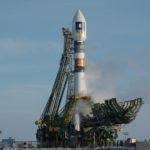GIOVE or Galileo In-Orbit Validation Element, is the name for two satellites to test technology in orbit for Galileo.
Giove is the Italian word for “Jupiter”. The name was chosen as a tribute to Galileo Galilei, who discovered the first four natural satellites of Jupiter, and later discovered that they could be used as a universal clock to obtain the longitude of a point on the Earth’s surface.
The GIOVE satellites are operated by the GIOVE Mission (GIOVE-M) segment in the frame of the risk mitigation for the In Orbit Validation (IOV) of the Galileo positioning system.
These validation satellites were previously known as the Galileo System Testbed (GSTB) version 2 (GSTB-V2). In 2004 the Galileo System Test Bed Version 1 (GSTB-V1) project validated the on-ground algorithms for Orbit Determination and Time Synchronization (OD&TS).
GIOVE satellites transmitted multifrequency ranging signals equivalent to the signals of future Galileo: L1BC, L1A, E6BC, E6A, E5a, E5b. The main purpose of the GIOVE mission was to test and validate the reception and performance of novel code modulations designed for Galileo including new signals based on the use of the BOC (Binary Offset Carrier) technique, in particular the high-performance E5AltBOC signal.
GIOVE-A
Previously known as GSTB-V2/A, this satellite was constructed by Surrey Satellite Technology Ltd (SSTL).
Its mission had the main goal of claiming the frequencies allocated to Galileo by the ITU. It had two independently developed Galileo signal generation chains and also tested the design of two on-board rubidium atomic clocks and the orbital characteristics of the intermediate circular orbit for future satellites.
GIOVE-A was the first spacecraft whose design was based upon SSTL’s new Geostationary Minisatellite Platform (GMP) satellite bus, intended for geostationary orbit. GIOVE-A is also SSTL’s first satellite outside low Earth orbit, operating in medium Earth orbit, and is SSTL’s first satellite to use deployable Sun-tracking solar arrays. Previous SSTL satellites use body-mounted solar arrays, which generate less power per unit area as they do not face the Sun directly.
It was launched at 05:19 UTC on December 28, 2005 on a Soyuz-FG/Fregat from the Baikonur Cosmodrome in Kazakhstan.
It began communicating as planned at 09:01 UTC while circling the Earth at a height of 23,222 km. The satellite successfully transmitted its first navigation signals at 17:25 GMT on 12 January 2006. These signals were received at Chilbolton Observatory in Hampshire, UK and the ESA Station at Redu in Belgium. Teams from SSTL and ESA measured the signal generated by GIOVE-A to ensure it met the frequency-filing allocation and reservation requirements for the International Telecommunication Union (ITU), a process that was required to be complete by June 2006.
The GIOVE-A signal in space was fully representative of the Galileo signal from the point of view of frequencies and modulations, chip rates, and data rates. However, GIOVE-A could only transmit at two frequency bands at a time (i.e., L1+E5 or L1+E6).
GIOVE-A codes were different from Galileo codes. The GIOVE-A navigation message was not representative from the structure and contents viewpoint (demonstration only purpose). The generation of pseudorange measurements and detailed analysis of the tracking noise and multipath performance of GIOVE-A ranging signals was performed with the use of the GETR (Galileo Experimental Test Receiver) designed by Septentrio.
GIOVE A was retired in June 2012, after being raised in altitude to make way for an operational satellite.
GIOVE-B
GIOVE-B (previously called GSTB-V2/B), had a similar mission, but with greatly improved signal generation hardware.
It was originally built by satellite consortium European Satellite Navigation Industries, but following re-organization of the project in 2007, the satellite prime contractor responsibility was passed to Astrium.
GIOVE-B also had MEO environment characterization objectives, as well as signal-in-space and receiver experimentation objectives. GIOVE-B carried three atomic clocks: two rubidium standards and the first space-qualified passive hydrogen maser.
The launch was delayed due to various technical problems, and took place on 26 April 2008 (22:16 UTC) aboard a Soyuz-FG/Fregat rocket provided by Starsem. The Fregat stage was ignited three times to place the satellite into orbit. Giove-B reached its projected orbit after 02:00 UTC and successfully deployed its solar panels.
GIOVE-B started transmitting navigation signals on May 7, 2008. The reception of the signals by GETR receivers and other means was confirmed at a few ESA facilities.
According to ESA, this was “a truly historic step for satellite navigation since GIOVE-B is now, for the first time, transmitting the GPS-Galileo common signal using a specific optimised waveform, MBOC (multiplexed binary offset carrier), in accordance with the agreement drawn up in July 2007 by the EU and the US for their respective systems, Galileo and the future GPS III”.
“Now with GIOVE-B broadcasting its highly accurate signal in space we have a true representation of what Galileo will offer to provide the most advanced satellite positioning services, while ensuring compatibility and interoperability with GPS”, said ESA Galileo Project Manager, Javier Benedicto.
After launch, early orbit operations and platform commissioning, GIOVE-B’s navigation payload was switched on and signal transmission commenced on May 7.
The GIOVE Mission
The GIOVE Mission Segment began in October 2005 with the purpose of providing experimental results based on real data to be used for risk mitigation throughout the overall Galileo In Orbit Validation (IOV) phase of the Galileo positioning system.
The GIOVE Mission segment infrastructure was based on evolution of the Galileo System Test Bed Version 1 (GSTB-V1) infrastructure conceived to process data from the GIOVE-A and GIOVE-B satellites.The GIOVE Mission segment was composed of a central processing facility called the Giove Processing Center (GPC) and a network of thirteen experimental Giove Sensor Stations (GESS).
The main objectives of the GIOVE Mission Segment experimentation were in the areas of:
- On-board clock characterisation
- Navigation message generation
- Orbit modelling


